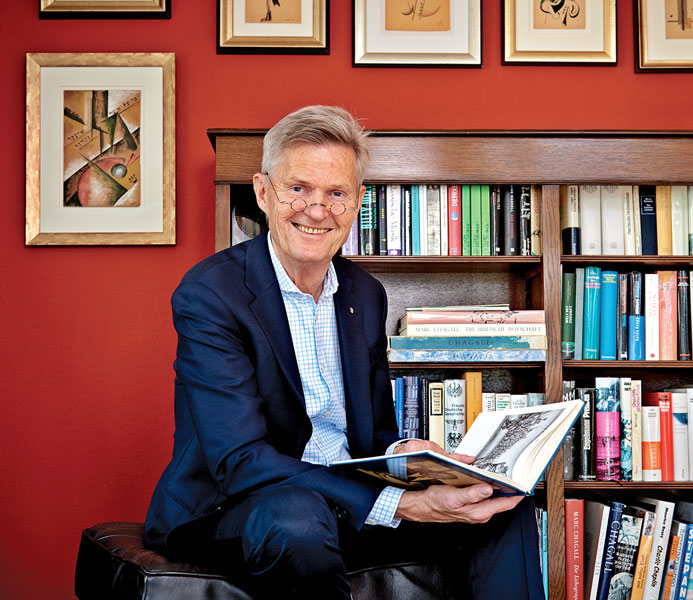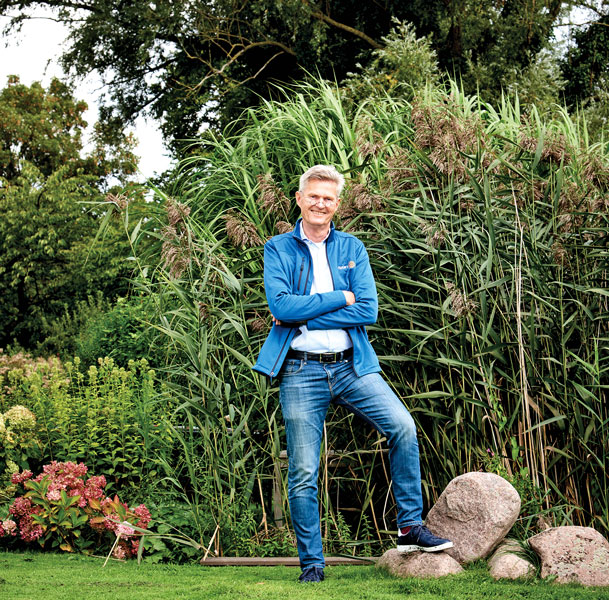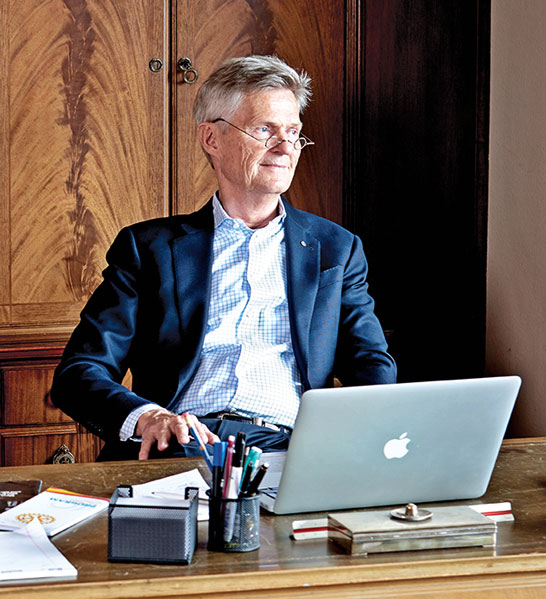Outside of One Rotary Center, it was an overcast October day. Lake Michigan shimmered a steely grey, and the trees’ red and orange leaves appeared drab.

But inside the office of Rotary’s President-elect, it was a bright new day, and not just because of the paisley handkerchief sprouting from the breast pocket of Holger Knaack’s blue blazer. Those vivid colours matched the cheerful attitude with which Knaack looks optimistically to the future — only one of the 67-year-old’s youthful traits.
Over two hours, on two separate occasions, Knaack sat down for a conversation with John Rezek, Editor-in-chief of The Rotarian, and Jenny Llakmani, the magazine’s Managing Editor. Speaking fluent, German-inflected English, Knaack discussed his atypical rise in Rotary, an ascent propelled by his longtime involvement with the Rotary Youth Exchange programme. Those experiences define his aspirations as president. “Growing Rotary, and especially growing with young members, will definitely be one of my goals,” he said. “Because if we lose contact with the younger generation” — he lifted his hands and shrugged — “we are outdated.”
During the conversation, Knaack discussed his January 2018 speech at the International Assembly, where he had quoted Paul Harris: “If Rotary is to realise its proper destiny, it must be evolutionary at times, revolutionary on occasions.” He then offered his own take on that thought: “To be prepared for the future, Rotary must continue to be revolutionary and must believe in the power of youth.”
Knaack introduced a few aphorisms of his own — including “There’s no wrong age to become a Rotarian” — and spoke about the economic necessity of having a presidential tie (Knaack, who rarely wears a tie, revealed that he keeps one of Mark Daniel Maloney’s blue presidential ties tucked into a desk drawer to have on hand if needed). He also introduced his presidential theme: Rotary Opens Opportunities. The phrase is paired visually with the silhouette of three open doors, one blue, another gold, and the third in bright Rotaract pink. He chose the theme for its aptness, explains Knaack, and because “it’s easy to translate in every language.” (In Knaack’s native German, it’s Rotary eröffnet Möglichkeiten).
During the first interview, Knaack’s wife, Susanne, sat in and provided clarifications. When Rezek asked Knaack about his reputation for being “unflappable,” the President-elect responded with a flapped expression. After briefly consulting her phone, Susanne provided a translation: unerschütterlich. With that settled, Knaack, ever imperturbable, continued the conversation.
The Rotarian: You’re the first president-elect from Germany in Rotary’s history. Tell us about the nature of Rotary in Germany.
Knaack: Rotary is different all over the world. We all share the same core values, but with different emphasis. In Germany, it’s really about friendship or fellowship — and it’s about integrity and ethics. That’s how German Rotarians look for members. And then the service we do grows out of friendship. I think one of the major points is that German Rotary clubs select their members carefully, and we have a very good retention rate. We don’t even think about retention.
TR: How did you get involved in Rotary?
Knaack: For me, it started with an organisation called Round Table, which has hundreds of clubs in Europe. Surprisingly, it was founded by Rotarians in England in 1927 who were tired of always hanging out with old men. So they created a new organisation, Round Table, but stipulated that you had to leave when you turned 40. I joined at 30 and left when I was 39. They had this wonderful motto: Adopt, Adapt, Improve. I was interested in service; I was also interested in networking. Many of my friends from this organisation joined Rotary, and again, the reason was the opportunity for networking, especially because of Rotary’s classification system. You need different people to make an organisation more interesting, to have discussions go in unexpected directions.
I was asked to join the Rotary Club of Herzogtum Lauenburg-Mölln. It’s a crazy name. When Ron Burton was a director, he once introduced me as “Holger Knaack from the Rotary Club of (pauses) somewhere in Germany.” A new Rotary club in my hometown, Ratzeburg, was looking for members, but I knew many of the people in that club already, so I decided to join the old club. It gave me the opportunity to meet totally different people.
TR: What was your pathway to the presidency of Rotary?
Knaack: I’ve been asked to list all the district leadership positions I held before I became a district governor. None. Zero. I didn’t have any before I became district governor, and I didn’t have any appointments in the district leadership. I was just known for my engagement in Youth Exchange, and because of that, people knew about me and my passion for Rotary. It was the same thing when I became a director: I had never, ever had any appointments at the zone level. When I came here to Evanston for my director-elect training, that was the first time I entered this building.
TR: What is it about Youth Exchange that makes it such a great programme?
Knaack: Youth Exchange was my path into Rotary. Susanne and I hosted Rotary Youth Exchange students and became involved in organising Youth Exchange camps, where Rotary clubs and districts host students from all over the world. And then I learned how this enriched our lives. We don’t have children ourselves, so this programme is really great for us. I think it keeps us young.
TR: We’ve heard that you are unflappable. Nothing upsets you. How can that possibly be true?
Knaack: I can sometimes be embarrassed because of small things, as my wife knows. But when confronted by serious things, when we have to make serious decisions, then I become more calm. Plus, I’m always counting on other people. I know I can’t do anything alone. I have the greatest respect for people who are doing the work — not just doing the work, but doing it with passion. We have to show our respect for all people like that. That’s what I learned very early.
TR: What areas are you going to concentrate on during your year? And what do you hope to accomplish?
Knaack: I have no crazy new ideas. We promised to eradicate polio, and I mean to do everything we can to keep that promise. If we succeed, it will help enhance how Rotary is seen in the world. No 2, of course, is growing Rotary, and that’s not just about growing our membership. It’s about growing Rotary at all levels. It’s about making our organisation stronger. It’s about retention and growing through new Rotary club models. Rotary is indeed one of the slowest-changing organisations in the world. What we do takes so much time. We have to be much faster.
TR: What about Rotary that don’t have to change?
Knaack: Our core values have always been the basis for what we do. Friendship, diversity, integrity, leadership, service — they will never be outdated. The way we express and live those values, that will change. Our tradition of meeting for a meal might have worked for 100 years. But it doesn’t work anymore, because lunch is no longer a central thing in your life. We have to look for models that young people are interested in. Let them decide what kind of Rotary club they would like to join to share our core values. Rotary is a place for everybody: for young and old, for old club models and for new club models. There’s no need for very strict rules. Let’s enjoy what fits best.
TR: Are you worried that the average age for Rotarians keeps going up?
Knaack: I’m so happy that our older Rotarians remain Rotarians and that older people still join Rotary clubs. They’re a great value for the clubs and our organisation. But I want to encourage Rotary clubs to think about their future. Clubs should have a strategic meeting twice a year. If they really think about their future, it’s important that there is no big gap between age groups. If they’re able to attract members in every age group, in every decade, then there is not a big gap. It’s important for Rotary clubs to stay on track and yet still be interesting for young professionals. It’s always dangerous if a Rotary club says, “OK, we have the perfect number of members. We have 50 or 60 or 70 or whatever; we don’t want any more members right now.” Then the gap can grow very, very fast. One of my sayings is, “There’s no wrong age to become a Rotarian.” If someone is 18 and becoming a member, that’s great. And if someone is 80, that’s great too. So there is no wrong age to become a Rotarian — and there’s no perfect size for a Rotary club.
TR: We notice that you don’t often wear a tie. Are you going to have an official tie?
Knaack: I learned that we bring in $1.3 million or $1.4 million a year from presidential ties and scarves. That’s a good reason to have one. I like ties. I have a large collection of ties.
TR: In very good condition, we bet. All right, there will be a presidential tie. What’s your theme?
Knaack: Rotary Opens Opportunities. It supports our efforts to grow Rotary, because becoming a Rotarian offers prospective members totally new opportunities.
One of the opportunities is, of course, the opportunity to serve. And then the other part comes into play: We offer opportunities to people who are waiting for our service — providing clean water, opportunities to go to school, and so forth. What we do works in both directions.
TR: People describe you as having a very young attitude. How do you think that will influence your leadership style when you’re president?
Knaack: I hope my leadership style will not change. Some people have said I don’t look presidential enough. But that’s OK. It’s about leadership, not about looking too serious. Besides, we really have to focus on young leaders to stay relevant in this world. We welcome our retirees because they have the skills, the time, and the passion to contribute. My focus is on innovative clubs, new club models, new club ideas, and young members. I think I can be the right person at the right time to attract more young members.
TR: How do you create the opportunities to bring younger people into leadership positions in Rotary?
Knaack: First of all, we have to rely on them and trust them. They are able to do many things — nearly everything. We should give them the opportunity to lead. Before I started the planning of the Rotary Institute in Berlin in 2014, I had a meeting with Rotaractors. I wanted to hear their ideas about doing something different, and they came up with great ideas. They organised all the breakout sessions, and they did a great job. So just trust them, rely on them.
TR: Is there a way to speed up the advancement of women into leadership positions?
Knaack: In a voluntary organisation, we can’t really push. It doesn’t work. We are a grassroots organisation; it all starts in our Rotary clubs. They should look to have the right people on the committees who nominate district governors. Have the right people there, and we will have more women as governors. Everything is possible: There will be six women on the 2020–21 Board of Directors that I will have the honour to chair.
TR: Do you imagine that it will have a different feel?
Knaack: There shouldn’t be any difference. We are all Rotarians regardless of gender. It’s about passion and leadership. We want the best people; it’s not about counting how many women. But I love that this is happening right now. The beauty of Rotary is indeed its diversity.
TR: How can we tell others about Rotary and improve our image in the world?
Knaack: It takes a long time, or a lot of money, to change your image in this world. Two things are important: You have to know it takes time, and then you have to be honest. It’s not because of marketing reasons that we have to change. We have to tell a true story of why we are doing things. To really be a part of Rotary, you have to be proud of the organisation, and we have to be proud of our work. Not about what you are doing. That’s selfish.
TR: Does Rotary need to be cooler?
Knaack: To be attractive for younger members, definitely. I’m proud of our existing Rotary clubs. But if they’re not attractive to Rotaractors or young professionals, we should encourage them to create a club model that works for them. And that’s what we’re going to do in the next few years.
© The Rotarian







